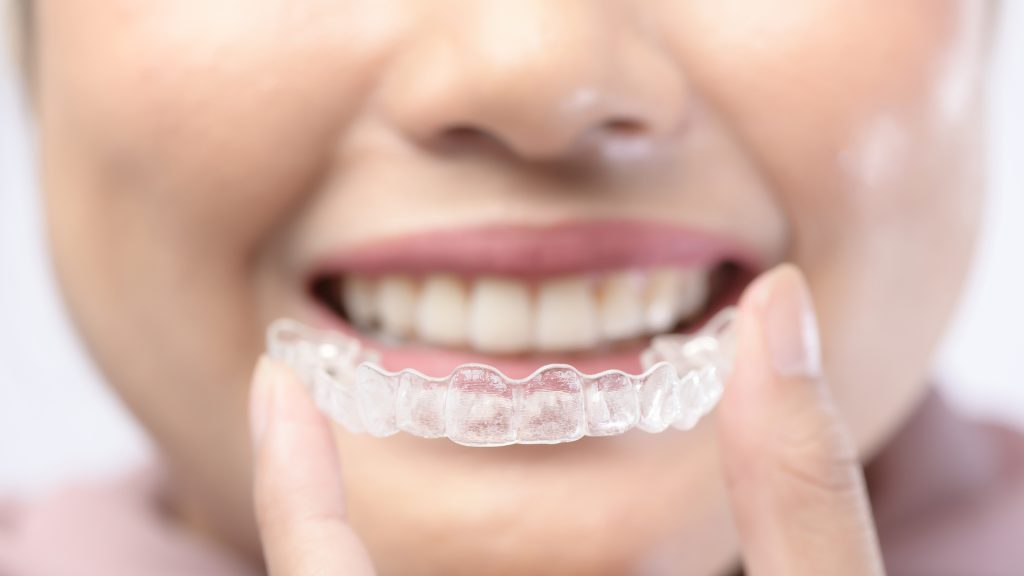Invisalign Tarneit
Discover the expertise of our dentists at Progressive Era Dental, where we’ve been transforming smiles for years with Invisalign® treatment in Tarneit! This clear, nearly invisible solution straightens your teeth with precision and care. With our exclusive ClinCheck software, every step of your treatment is meticulously planned—no guesswork, just precise, predictable results from your first aligner to your perfect smile. Our 3D visual interface lets us customize your treatment to fit your needs. Experience personalized, compassionate dental care at Progressive Era Dental, proudly serving multiple locations, including Tarneit.

What is Invisalign®?
Invisalign® is a modern orthodontic treatment that gradually straightens teeth using a series of clear, removable aligners. Unlike traditional braces, which use metal brackets and wires, Invisalign® aligners are made from a smooth, transparent plastic material, making them almost invisible when worn.
The treatment begins with a digital scan or mould of your teeth, which creates a 3D mouth model. Using this model, your dentist or orthodontist creates a custom treatment plan using specialized software, like ClinCheck, that maps out the precise movements your teeth will undergo throughout the treatment.
Patients wear each set of aligners for about one to two weeks before switching to the next set in the series. Over time, the aligners gently shift the teeth into their desired positions. Because they are removable, patients can take them out to eat, drink, brush, and floss, making them a convenient and comfortable option for many people.
What are the advantages of Invisalign?
Invisalign offers several advantages over traditional braces and other orthodontic treatments:
- Aesthetic Appeal: Invisalign aligners are clear and nearly invisible, making them a discreet option for straightening teeth. This is especially appealing to adults and teens who may feel self-conscious about wearing metal braces.
- Comfort: The aligners are made from smooth, medical-grade plastic, which is more comfortable than metal braces that can irritate the cheeks and gums.
- Removability: Invisalign aligners can be removed for eating, drinking, brushing, and flossing. This means you don’t have to worry about food restrictions or difficulties with oral hygiene that are common with traditional braces.
- Predictable Results: With advanced software like ClinCheck, your treatment is precisely planned from start to finish. You can see a virtual representation of how your teeth will move, and your smile will look at the end of the treatment.
- Shorter and Fewer Appointments: Invisalign often requires fewer orthodontic visits than traditional braces, as there are no brackets or wires to adjust. Patients usually only need to check in with their orthodontist every 6-8 weeks.
- Versatility: Invisalign can treat many dental issues, including crowded teeth, gaps, overbites, underbites, and crossbites. It’s effective for both simple and more complex cases.
- Better Oral Hygiene: Since the aligners are removable, it’s easier to maintain good oral hygiene than traditional braces, where brushing and flossing can be more challenging around brackets and wires.
- Less Interference with Daily Life: Because the aligners are so discreet and comfortable, they have minimal impact on daily activities. Many people find it easier to adapt to Invisalign than to traditional braces.
- No Food Restrictions: Unlike traditional braces, Invisalign doesn’t require you to avoid certain foods. Simply remove the aligners when you eat and enjoy your meals without worry.
Does Invisalign hurt?
Invisalign is generally considered more comfortable than traditional braces. Still, some discomfort is expected, especially when starting a new set of aligners. Here’s what you might experience:
- Mild Soreness: When you first put on a new set of aligners, you may feel pressure or soreness in your teeth. This is normal and is a sign that the aligners are working to move your teeth into their new positions. The discomfort is usually mild and typically lasts for a few days.
- Adjusting Period: When you first start wearing Invisalign, getting used to the sensation of having the aligners in your mouth might take a little time. Some people experience slight irritation on their gums, lips, or tongue, but this usually subsides as you adjust to the aligners.
- Less Painful than Braces: Compared to traditional braces, Invisalign is generally less painful because there are no metal brackets or wires to cause cuts or irritation. The pressure applied by Invisalign is more gradual and gentle.
- Tips for Reducing Discomfort: To minimize discomfort when switching to a new aligner, you can try putting it in at night so you sleep through the initial adjustment period. Also, chewing on “chewies” (small, soft cylinders) can help the aligners fit better and relieve some of the pressure.
While some discomfort is normal as teeth move, most people find Invisalign to be a relatively painless and comfortable way to achieve a straighter smile.
Do I need to wear my aligners all day?
To achieve the best results with Invisalign, you need to wear your aligners for most of the day—typically around 20 to 22 hours each day. This means you should keep them in while you’re awake and even when you’re sleeping. The only times you should remove your aligners are:
- Eating and Drinking: Remove your aligners whenever you eat or drink anything other than water. This prevents staining and damage to the aligners and ensures that food particles don’t get trapped between your teeth and the aligners.
- Brushing and Flossing: Remove your aligners to brush your teeth thoroughly. This helps maintain good oral hygiene and keeps your teeth and gums healthy throughout treatment.
- Cleaning the Aligners: It’s essential to clean your aligners regularly to keep them clear and free from bacteria. You can also remove them for this purpose.
Wearing your aligners consistently is crucial for the treatment to work effectively. Not wearing them enough could delay your progress, or your teeth might not move as expected, potentially prolonging the overall treatment time. If you’re worried about remembering to wear them, setting reminders or putting them back in immediately after meals and brushing can help keep you on track.
How long does Invisalign treatment take?
The length of Invisalign treatment varies depending on the complexity of your case, but most treatments typically last between 12 and 18 months. Some patients may see results in as little as 6 months, while more complex cases can take up to 24 months or longer.
Several factors influence the duration of your treatment:
- Severity of Misalignment: Minor adjustments, like closing small gaps or slightly straightening teeth, may take less time. More complex issues, such as significant crowding or major bite corrections, will take longer.
- Consistency in Wearing Aligners: The more consistently you wear your aligners (ideally 20 to 22 hours per day), the more efficient the treatment will be. Inconsistent wear can extend the treatment time.
- Treatment Plan: Your orthodontist or dentist will create a customized treatment plan using Invisalign’s ClinCheck software. This software outlines the exact movements of your teeth and estimates the total treatment time.
- Number of Aligners: Your total number of aligners can vary based on your treatment plan. Each set of aligners is typically worn for one to two weeks before switching to the next set.
- Compliance: Following your orthodontist’s instructions, such as using any prescribed attachments or rubber bands, can also affect the treatment timeline.
While your dentist or orthodontist will give you an estimated time frame at the start of your treatment, it’s important to remember that this is an estimate. Regular check-ups will help monitor your progress, and adjustments to the treatment plan can be made if necessary to keep you on track.
Can I eat and drink while wearing aligners?
It would help if you did not eat or drink anything other than water while wearing your Invisalign aligners. Here’s why:
- Avoid Staining and Damage: Eating or drinking anything other than water can stain or damage the aligners. Foods and beverages can leave behind residues that can discolour the clear plastic, making your aligners more visible and less attractive.
- Prevent Trapped Food Particles: Eating with your aligners can trap food particles between the aligners and your teeth, leading to plaque buildup and potentially causing cavities or gum problems.
- Maintaining Oral Hygiene: Removing your aligners to eat and drink allows you to brush and floss after meals, helping you maintain good oral hygiene throughout your treatment.
- Avoiding Warping or Distortion: Hot beverages, such as coffee or tea, can warp the plastic of the aligners, affecting their fit and potentially hindering your treatment progress.
To avoid these issues, always remove your aligners before eating or drinking anything other than water. After eating, brush your teeth before putting your aligners back in, or at least rinse your mouth with water if brushing isn’t possible. This helps keep both your teeth and aligners clean and fresh.
What do I do if my aligners break?
If your Invisalign aligners break, taking action quickly is important to avoid disrupting your treatment. Here’s what you should do:
- Contact Your Dentist or Orthodontist: Contact your dental provider as soon as possible to inform them about the broken aligner. They will give you specific instructions based on your treatment plan.
- Save the Broken Aligner: Keep the broken aligner, even if it’s in pieces. Your dentist or orthodontist may want to see it to assess the damage and determine the best action.
- Continue Wearing the Broken Aligner (If Possible): If the aligner is only slightly damaged and still fits comfortably, you may be advised to continue wearing it until you receive a replacement. This will help maintain your treatment progress.
- Use the Previous Aligner: If the broken aligner is unusable and you can’t get a replacement immediately, your dentist might recommend wearing the previous aligner in the series to keep your teeth from shifting back.
- Move to the Next Aligner (If Close to the Switch Date): If you were close to the scheduled switch date for your next aligner, your dentist might suggest moving on to the next one early. However, this decision should only be made after consulting with your dental provider.
- Request a Replacement: Your dentist or orthodontist can order a replacement aligner, which may take a few days to arrive. In the meantime, following their guidance on how to manage your treatment is crucial to avoid delays.
Breaking an aligner is common, and dental providers are experienced in handling these situations. By acting quickly and following professional advice, you can minimize any impact on your treatment timeline.
When will I start seeing results?
Most people notice changes within the first few weeks of wearing Invisalign aligners. Still, the timing can vary depending on your specific case. Here’s a general idea of what to expect:
- Initial Changes: In the first few weeks, you might notice subtle shifts in your teeth, especially in areas where the aligners work to correct minor misalignments or gaps. These changes may be more noticeable when you compare your teeth to photos taken before you started treatment.
- 3 to 6 Months: By this time, the results are typically more apparent. You’ll likely see a more noticeable improvement in your teeth’s alignment. Friends or family members might even start to comment on the changes.
- Midway Through Treatment: For many patients, significant results are visible by the midpoint of their treatment. Depending on your treatment plan, this could be around 6 to 9 months into the process. Your teeth will likely look much closer to their final positions at this stage.
- Final Results: The most dramatic results will be visible by the end of your treatment, typically from 12 to 18 months. By then, your teeth should be in their final, straightened positions, giving you the smile you’ve been working toward.
You’ll have regular check-ups with your dentist or orthodontist throughout your treatment, who will monitor your progress and make any necessary adjustments. It’s important to wear your aligners as directed (20 to 22 hours a day) and follow your provider’s instructions to achieve the best and fastest results.
How much does it cost in Tarneit?
Call us at (03) 9071 3030 to schedule your appointment or get all the details on costs. We know how important it is to understand your options, and we’re here to ensure you have all the information you need to make the best choice for your dental care. We’re excited to talk with you!


